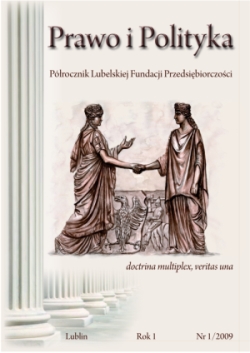Dyskusyjne epizody unii Korony z Litwą, 1385-1793
Episodes of the Polish-Lithuanian union, 1385-1791: points of discussion
Author(s): Andrzej ZakrzewskiSubject(s): Diplomatic history, Political history, International relations/trade, 13th to 14th Centuries, 16th Century, 17th Century, 18th Century
Published by: Fundacja Niepodległości
Keywords: Polish-Lithuanian Commonwealth; Union of Lublin (1569);
Summary/Abstract: Researches on Polish–Lithuanian relations have a long tradition in scholarship of countries in the region. However, they have been often connected with current politics – not only in Poland and Lithuania – but also in Germany, Russia, Belarus and Ukraine. Nowadays it is possible to analyze the past without various kinds of political burdens, even though the tradition has still its impact. In 1976 Lithuanian historian in exile Jonas Dainauskas published a study denying an authenticity of the act of Krewo in 1385. It started a serious debate over this problem. As a result of it both Polish and Lithuanian scholars acknowledged authenticity of the act, stating though that it was rather a marital contract than an act of union between two countries. Despite its nature, a practical result of the act was a personal Polish-Lithuanian union (broken twice for short periods: 1440-1447 and 1492-1506) Union of Lublin (1569), which tightened the relations between two countries, is a subject of admiration in Poland. In Lithuania it is rather treated as perceived necessity in a face of aggression from Moscow. Both countries had common king–grand duke and parliament. Tere were separate: offices, laws, courts and treasures. Political elites of the Grand Duchy of Lithuania had fought for equal position of Lithuania in relations with the Kingdom of Poland for decades. ^is goal had been achieved during a long reign of Sigismundus III (1587 – 1632). ^e Grand Duchy of Lithuania and the Kingdom of Poland were both equally threatened by Sweden. For Lithuania however, the Moscovian threat was far greater than for Poland. Terefore there were discrepancies in foreign affairs from time to time: in 1626-1627 Lithuania signed separately three armistices with Sweden. It raised protests in Poland as Polish army was put in a difficult position in their military fighting against Sweden. Since 1655 the Grand Duchy of Lithuania had been occupied by Moscovian and Swedish armies. Under these circumstances the agreement of Kiejdany (20th October 1655), which tied Lithuania with Sweden, was signed. ^ere has been various assessments of the agreement. Traditionally, it has been treated as an act of treason or an attempt to find a solution in a hopeless situation. Some Lithuanian nobility recognized Swedes as the lesser of two evils. On the other hand some part of the nobility, who found themselves under Moscovian occupation and had not decided to leave their substance, made a proposal of a parate union of the Grand Duchy of Lithuania with Moscow. A desire to avoid Swedish rules and a need for some sort of agreement with Moscow were the main reason for such an attitude. Pacts with Sweden and Moscow were not signs of Lithuanian separatism: nobody thought in categories of the whole state while concluding them. Their aim was just to save particular territories under occupation from persecutions. In 1700 or 1701 Resolution of Vilnius (Postanowienie wileńskie) was concluded. A part of the Lithuanian nobility, hostile towards Sapiehas, decided to give hereditary reign over Grand Duchy to king August Wettin and to renounce a major part of their political rights in this act. However, it seems that the resolution is a forgery: a libel created by Sapiehas who tried to discredit their political rivals. ^us, it is hard to treat it as an infringement of the Union of Lublin. Constitution of May 3 might be recognized as an act which silently repealed a distinction of the Grand Duchy of Lithuania. However, the Mutual Guarantee of Two Nations (Zaręczenie Wzajemne Obojga Narodów) passed on 20th October of that year emphasized that the Kingdom of Poland and the Grand Duchy of Lithuania are equal parts of the Commonwealth. In 16th and 17th centuries Lithuanians realized that the Polish-Lithuanian union was a necessity (at least for military reasons). Therefore theses on attempts of independent actions of the elites made in favour of the whole of Grand Duchy as a separate state are not convincing enough, they need a sterling evidence. In 18th century processes of integration in the Polish-Lithuanian Commonwealth became much deeper and signs of Lithuanian separatism are hardly noticed. However, a sense of Lithuanian distinction was still used in political showdowns.
Journal: Prawo i Polityka
- Issue Year: 2009
- Issue No: 1
- Page Range: 13-22
- Page Count: 10
- Language: Polish

